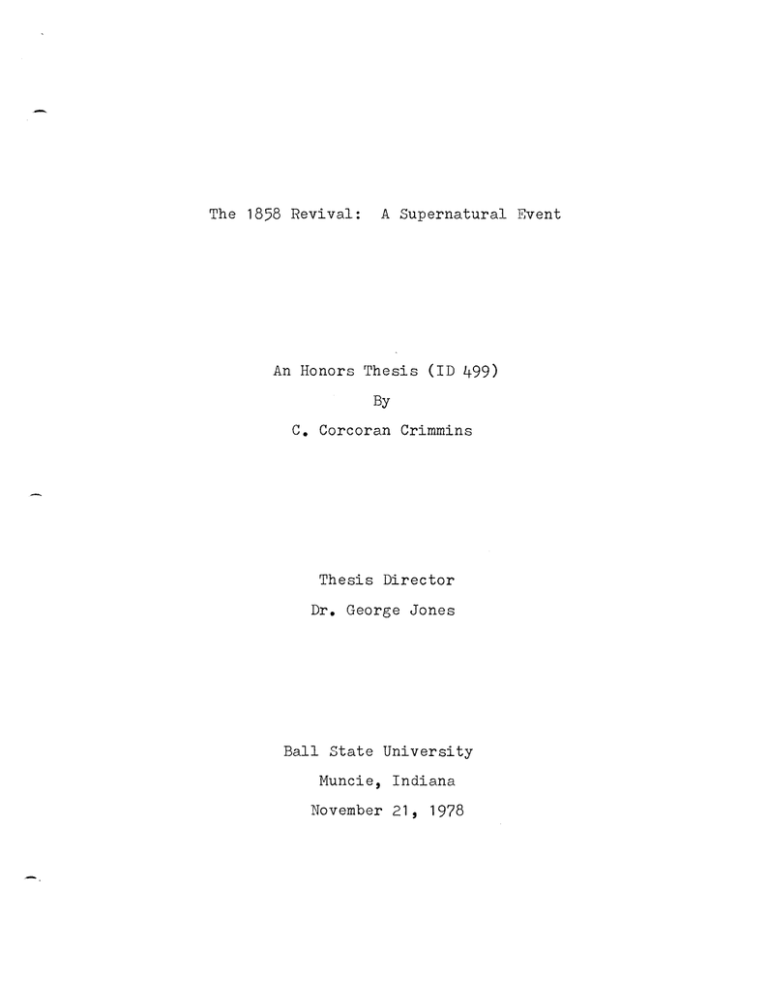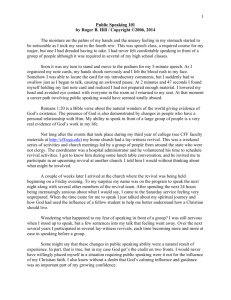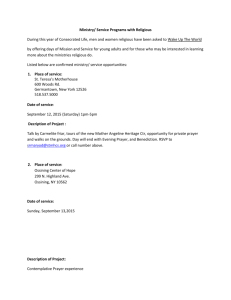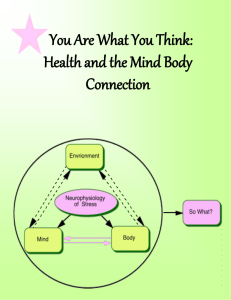1858 499)
advertisement

The 1858 Revival:
A Supernatural Event
An Honors Thesis (ID 499)
By
C. Corcoran Crimmins
Thesis Director
Dr. George Jones
Ball State University
Muncie, Indiana
November 21, 1978
5,} t.o"
-Tre';!
LO
.? l, :3 )'
"
....
Man throughout time has continually sought to explain the
supernatural by way of the material.
In 1858 a revival swept across
the United States and later other countries around the world.
Many
conclude it was a result of political, social, economical and
religious conditions of the day.
The purpose of this thesis is to
demonstrate that a supernatural revival took place in the United
states, a revival not the result of natural circumstance but a
result of a supernatural God's origination.
To begin, it is necessary to first explain what is meant by
revival.
The word revival began to emerge in religious circles
during the beginning of the 19th century.
When the word revival
was first used by the clergy, it was used with negative connotations.
To hold a revival in the church implied that the church
members had fallen away from their earlier holiness, reverence, and
worship.
Revival was a means of reprimand and exhortation to cause
the members to return to their former spirituality. 1 But the term
revival can have positive implications as it does bring about a
positive change in people's relations to God.
A revival doesn't just affect weary believers, but is meant
to affect non-Christians as well.
Because this is true, a revival
and an evangelical awakening are the same thing.
J. Edwin Orr
describes a revival or an evangelical awakening as follows:
An evangelical awakening is a movement of the Holy
Spirit bringing about a revival of New Testament
Christianity in the Chruch of Christ and its related
community. Such an awakening may change in a significant wayan individual only; or it may effect
a larger group of believers; or it may move a
2.
congregation, or the churches of a city or district,
or the whole body of believers throughout a country;
or a continent; or indeed the larger body of believers throughout the world. The outpouring of the Spirit
effects the reviving of the church, the awakening of
the masses and the movement of the uninstructed peoples
towards the Christian faith; the revived Church, by
many or few, is moved to engage in evangelism, in
teaching and in social action. 2
To clarify then, a revival can be defined as the means to
reach a spiritually dead (those who do not accept Jesus as their
Savior) or spiritually asleep (those who have asked Jesus into
their lives as Savior and Lord but aren't letting Him have control
of their lives--they aren't living for Him) society with the claims
of Jesus' love, man's sin and its
ness through faith in Him.
penalty, and Jesus' forgive-
A revival can renew or begin a right
relation with God.
Because revival is not only a renewal of Christians' love and
zeal for the Lord, but also an establishment of that relationship,
Acts 2:14-17 can be considered the first written record of revival
in the history of the Christian Church even though it is also one
of the beginning events in the formation of the church.
Jesus had promised the outpouring of His Holy Spirit to the
disciples.
While they waited in the Upper Room in Jerusalem,
suddenly there was the sound of rushing wind, tongues of fire and
the disciples experienced the filling of themselves by the Holy
Spirit. 3
Peter told the people gathered in Jerusalem of Jesus Christ
and His claim to be the Messiah or Savior for mankind.
Three
thousand men from a variety of nations responded and were baptized.
As a result, they "were continually devoting themselves
to the apostle's teaching, and to fellowship, to the breaking of
3.
bread and to prayer.,,4
They began sharing among one another,
meeting each other's needs and many people continued to believe in
Jesus as Savior and join their ranks.
Other long term results,
the initial spreading of Christianity in the immediate area, the
conversion of Saul of Tarsus, and the outreach of Christianity
are recorded in the continuing chapters of Acts.
This type of outpouring of the Holy Spirit is not to be confused with what are called revivals today in the 1970's.
These
revivals for the large part have become commercialized, attentiongetting devices to attract new members and/or to psyche-up emotionally those currently attending.
The key points in Orr's descrip-
tion, an outpouring of the Holy Spirit resulting in social change,
evangelism and teaching,5 seem to have been forgotten or lost in
most of the modern "weekend" services of this current age.
The United States of America has gone through many changing,
rearranging times and the mid 19th century was no exception,
especially in the areas of politics, social and religious circles
and economics.
Politically speaking, the United States was going
through many changes and trials.
During this time, the Democratic
Party was splitting and the Whigs, having already fallen apart,
regrouped with the Ku Klux Klan and other no-name parties to resurface as the Republican Party.
Around the early 1850's a polit-
ical party called the Know-Nothings emerged into politics.
The
Know-Nothings, a growing anti-Catholic and anti-foreigner party,
reached its peak of power during the 34th session of Congress.
Fortunately, even then, they still held no more power than the
Democratic of Republican parties.
After the 34th session, they
began to decline in importance until finally the issue of slavery
split what was left of the Know-Nothings, who had become by then
a small party.6
Slavery was dividing the nation as well.
In the United States,
by the middle of the 19th century, slavery was the burning topic in
everyone's mind.
It effected all aspects of life.
people wondered if it was morally right.
if it was proper.
Religiously,
Socially, people wondered
Economically, people questioned its necessity
for our country's survival.
It was left up to the politicians to
find the answers and the politicians weren't finding any solution
for it.
The change within the political parties, the rise of
prejudiced political factions and the explosive issue of slavery
gave the appearance that politically, America was headed for turbulent times.
Socially, people were becoming more materialistic and wealthoriented. 7
The industrialization of cities and immigration sent
many city dwellers, who could afford to do so, scurrying to the
suburbs.
Streets once filled with the families of substantial
and opUlent citizens were invaded by shops and warehouses, and in a short time entire rows of houses which
formerly had served their occupants at once for a place
of business and a place of dwelling, were replaced by
stately blocks adapted solely to business purposes. 8
The exchange of past parishioners with new immigrants had an adverse
effect on the churches.
The middle city churches began to lose
membership.9
New layman were contracted in the effort to reach the
new immigrants but not always ending vdth huge success. 10
Churches were in a state of confusion also.
Suffering from
a previous setback, a false prediction of Christ's return, many had
rejected the reliability and
authenticity~
the Christian truths.
5.
After years of Bible study, William Miller declared he had disIn 1828, he felt the
covered the date Jesus was to return again.
inner urgings to tell everyone of his discovery.
look for the coming of the millenium.
amassed more and more followers;
career.
Society began to
As the time drew nearer, he
50,000 during the peak of his
But when the time came and passed, his followers became
°
11
lS e levlng.
b lOtt er, dOblo
Many t urne d away f rom fOthO
al
In Gd
o.
Church became a source of humor for many;
Th e
not the best atmosphere
for a revival. 12
Another important event during this time was the financial
crash of 1857.
A collapse of the banking system in October of
1857 spread panic through out the land.
Banks failed, the rail-
roads went bankrupt, the shipping industry was crippled, and
factories closed down.
Laborers were hit hardest as the unem-
ployment rates grew, and there was no relief to be found in the
labor market as it was letting people go right and left. 13
In
New York City, as a result of the crash some 30,000 men were
unemployed by 1858. 14
Comparing this financial crash to others in history, it was
less severe than crashes before and after it.
The crash in 1837,
which reverberated throughout the world was said to be "ten fold
more disastrous" than the succeeding crash of 1857. 18
As com-
pared to the crash of 1929 and the Great Depression, the financial
crash of 1857 was mild.
Yet amid political change, social ma-
terialism, religious skepticism, and financial crisis, " ••• there
came another great awakening surpassing previous movements in
extent, wholesomeness, effects and lasting impact, ••• ,,1 5
The rev:Lval of 1858 began on Wednesday, September 23, 1857;
with a man named Jeremiah Lanphier.
On July 1, 1857, Lanphier
6.
was appointed missionary to the city from the North Dutch Church
on Fulton street in New York City.
Due to the loss of membership,
he was appointed to recruit new members for the church.
to go door to door canvassing the neighborhood.
He chose
By September
Jeremiah Lanphier decided to hold a prayer meeting at noon on
Wednesdays.
He had found strength and comfort in prayer and
wanted to provide an opportunity for others to reap the benefits
of prayer.
1 ".
0
He began to mention the prayer meetings scheduled for the
23rd of September as he canvassed the area.
He distributed flyers
that read:
HOW OF'rEN SHALL I PRAY? As often as the language of
prayer is in my heart; as often as I see my need of
help; as often as I feel the power of temptation; as
often as I am made sensible of any spiritual declension
or feel the aggression of a worldly spirit. In prayer
we leave the business of time for that of eternit~
and intercourse with men for intercourse with God. 17
Jeremiah Lanphier posted the flyers throughout the neighborhood.
On the reverse side the flyer made it clear that all were
invited and could come and go as they had time. 18
On that first Wednesday, at noon, Lanphier vias the only one
present.
At 12:30 he heard footsteps on the stairs coming uP.
Later another, then another, until six men gathered together for
prayer that day.
The second week twenty persons were there.
At
the third meeting, it was decided that they should meet daily
for prayer. 19
At first,the attendance was small, but by the end of six
months at least 60,000 men were meeting daily for prayer. 20 In
the beginning those in attendance were all men, but after a period
7.
of time, women began to come also. 21
Eventually, the meetings
became so c:c-owded that they had to find other spots throughout
the city to pray.
"During the weeks that followed the increase in
attendance was slow but sure. Men of all classes
and conditions attended the service. Capitalists
and laborers, manufacturers and artisans, professional men, merchants, and clerks, butchers and
bakers:, men from every walk in li fe \vere represented from day to day. Laymen would drive up to
the curbstone and securing their teams would enter
the service long enought for the singing of a hymn
or a s~ason of prayer, and then be off to their
work." u :::'
About the time of the third prayer meeting in the city of
Hamilton, in Ontario, Canada, Walter and Phoebe Palmer were beginning to reap the rewards of their own evangelism.
Mr. and
Mrs. Palmer were to report that an estimated three to four
hundred people made public professions of fatih in Jesus as their
Savior.
The conversions here were largely a result of lay efforts
that were to spread throughout the city.
even participated in the services.
The mayor of the city
Attendances at the meetings
were recorded as having been between 5,000 and 6,000 for the entire fall period. 23
Back in the States the revival continued to spread.
Although
New York was not then an irreligious city, religious changes began. 24
By the Spring of 1858, there were twenty daily gatherings of
people for prayer.
Fire departments and police stations opened
their doors as prayer sites. 25 At the Thirteenth Presbyterian
Church, one hundred thirteen people made public their profession
of faith. 26
8.
It was not until February that newspapers
something was happening.
began to notice
Soon the New York papers had to publish
extras to give the public the details of what was really taking
place. 27 The publicity fanned the flames of revival.
In Brooklyn, there was recorded seventy-five converts for
the month of January.28
Burton's Theatre in Brooklyn was requested
as a place for noon prayer.
Hr. Burton, the owner, was in hearty
agreement and even ash:ed that he be the target of some of their
prayer.
crowded.
At the first prayer meeting, by 11:30, the theatre was
By noon no one could get within sight of the stage.
As many as fifty clergymen were in attendance.
The majority of
those present were men, although two hundred women did come.
"People clung to each projection along the walls, and they piled
themselves upon the seats, and crowded the stage beneath, above,
and behind the curtain. 1I29
In nearby Yonkers during the month of
January there were ninety converts 30 as a result of a local revival.
The revival spread on to Albany.
Six legislators decided to
begin an early morning prayer breakfast in addition to the daily
noontime meetings.
They used the Court of Appeals rooms for
prayer, but these soon became overcrowded. 31
The revival spread to Philadelphia, Boston, and other big
cit:.es. 32 But "small towns and rural communities were as powerfully
affected as the great cities.,,33
In Philadelphia, a young member of the Y.M.C.A. attended one
of the prayer meetings in New York.
Encouraged and motivated, he
returned, explained what was going on in New York, and expressed
the desire to start a prayer meeting in Philadelphia.
there were never more than thirty-six in attendance.
At first,
Then they
9.
changed the locale to a more centralized location.
Then the number
of those in attendance increased to the point that for weeks 3,000
were coming daily for prayer.
for the firemen.
The city established a prayer time
It was estimated that 10,000 people were con-
verted "\vi th:Ln a year's time. 34
In
Bet~el,
Conneticut, businesses were stopped between the
hours of 4:00 p.m. to 5:00 p.m. so there might be a time of prayer.
Two hundred people were converted in tvvo months.
One unnamed town
in Conneticut reported there was not one unconverted adult in the
town. 35
The revival spread from the Northeast, over the Alleghenies
and into the deep South.
One New York paper published an inter-
denominational account of the conversions occuring during the few
months preceding May, 1958.
Maine
New Hampshire
Vermont
Massachusetts
Rhode Island
Conneticut
New York
New Jersey
Pennsylvania
Ohio
Michigan
Indiar:.a
2,670
1 ,376
770
6,254
1 ,331
2,799
16,674
6,035
6,732
8,009
8,081
4,775
Illinois
vVisconsin
Minnesota
Iowa
Missouri
Kentucky
Tennessee
Delaware
Maryland
Virginia
Deep South
California
10,460
1,467
508
2,179
2,027
2,666
1,666
179
1,806
1,005
1,494
50
During the few months before May, 1858, he estimated 96,216
conversionE: across the country.36
Another estimated 50,000 con-
verts a week and 10,000 new members were added to the church. 37
Over the Alleghenies, by the beginning of 1858, four hundred
and eighty towns reported 15,000 public professions of faith at
prayer meetings.
Cleveland, Cincinnati, Louisville, Indianapolis,
Detroit, Chicago, st. Louis, and Dubuque began to see revival.
10.
Village and country areas were affected also throughout Kentucky,
Ohio, Michigan, Indiana, Illinois, Wisconsin, Missouri, and Iowa. 38
In Kentucky, a Masonic Temple was designated as the place for
prayer meetings.
More than 1,000 people flocked to attend.
On
one Ohio river steamer, the topic of conversation was revival.
A prayer meeting began "spontaneously and crowded H in, of all
places, the main saloon.
Fifty towns in Missouri reported 2,000
converts. 39
Another interesting incident of revival in the West occurred
in Minnesota.
Tired of being cheated, conned and pushed out of
their territory, the Sioux Indians, led by medicine men, staged an
all-out attack covering 20,000 square miles.
They killed 600
people, destroyed missions and burnt Christian Indians' homes.
Finally, the army stopped them, executed 38 of the warriors and
imprisoned ,+00 others.
Two men, William and Breggs took this
opportunity to tell these warriors about personal relationships
with Christ, teaching them reading and writing skills also.
less than a year, 300 braves were asking to be baptized.
squaws were not overlooked either;
Within
The
but instead had opportunities
to hear the good news of Jesus Christ.
Four years later, when the
families were reunited, 400 of them grouped together to build a
church. 40
As far west as San Francisco, more than a dozen churches grew
to 9,000 in membership and many persons were converting to
Christianity.
HAn increasingly great interest was reported from
the interior of California, with prayer meetings multiplying in
Sacramento, Marysville, and San Jose.,,4 1
Although Charles Finney did not believe the South was affected
11.
by revival due to the hold "sinful" slavery had upon it, other more
recent sour:es differ. 42 Bishop Candler noted the South's participation in r8vival was, with regard to proportions of the populations, greater than that of the North.
The South was not urbanized,
the population being more spread out than in the North.
years of
18~58,
During the
1859 and 1860, the South had a total of 100,000
converts in the Methodist Church.
The Baptists are recorded as
having an equal amount of conversions also. 43
The services during these revivals were not devoted so much
to preaching as to prayer.
They were void of the fanaticism, mass
hysteria and over indulgent emotionalism. 44
Referring to prayer
as the fulcrum, one man attending one of Finney's meetings said,
"I am from Omaha, in Nebraska.
On my journey east, I have found
a continuouE prayer meeting all the way.
miles from Omaha to Boston;
'lIe
call it two thousand
and here was a prayer meeting about
two thousand miles in extent.,,45
This revival did not affect the United States alone.
It went
on to Ireland, Scotland, \Vales, India, and Africa to name just a
few countries.
In Wales, crime dropped so much that the policemen
had to try to find new ways to occupy their time.
to file for baru{ruptcy.46
Saloons began
But, this thesis deals with the revival
of 1858, ane its events in the United States.
Now, two terms need to be defined to clarify this thesis,
supernatural and miracle.
~
American Heritage Dictionary Qf
English Language defines supernatural as:
~
"of or pertaining to
existence outside of the natural world, not attributed to natural
forces, attributed to the immediate exercise of divine power,
miraculous, ••• ,,47
This dictionary defines a miracle as "an event
that appears unexplainable by the laws of nature and so is held
12.
to be supernatural in origin or an act of God. "L+8
More simply a
miracle, or something miraculous, is the same as something supernatural.
T~e
key is that they attribute something that cannot be
accounted for by natural sourCE,;-=: to the Divine.
These terms do
not mean to imply that natural forces are not involved;
but it
does mean to imply the act originated with God and natural forces
should not
~e
credited with the origination of the event.
In order for something to be supernatural the human element
mayor may not be present.
Very often man has been described as
God's hands on earth, not that God needs man but as men are
yielded God chooses to use them for His glory.
both the Old and New Testaments.
participanta.
This is seen in
Humans do not have to be active
They can at times function as observers only, but
they also can be tools (not to be confused with the Originator)
in miracles.
The above then answers the question could God act through men
and in concert with men.
Yes.
God does act through men but He is
always the Originator of the miraculous.
Thus although the thesis
is God caused, or originated, the circumstances leading to and the
supernatural events during the revival of 185& the human element
was active in many ways.
The question may be asked does the presence of "timely"
circumstances disprove divine action?
No, the presence of such
circumstances does not disprove God's intervention.
question should be asked and answered.
But a second
Were the circumstances
surrounding the 1858 revival "timely", in the sense that they
lead up to or were causal for the revival?
13.
Many historians credit the financial crash of the banking
system in 1857 as the originator of the great awakening of 1858.
Historians record that man in his desperate straights seeks comfort from a god like being;
time of insecure instability.
something familiar to cling to in a
Yet, the financial crash of 1837,
which was described earlier as 10 times more disastrous than the
crash of 1857, shook the world's financial system.
At that time
there were scattered camp meetings and evangelism occurring
throughout the country.
God.
But there were no great masses turning to
In the stock market crash of 1929 the world's financial
system was dealt another heavy blow, but the people through the
world again did not experience conversions in the same proportions as in the revival of 1858 by any stretch of the imagination.
This does not mean to imply that the financial crash did not
effect the revival of 1858.
The financial crash did take place
and it surely had an impact on many individuals' personal lives.
But just as other, more severe crises did not have enough impact
to convert men's hearts to Christianity, the impact felt by this
less severe financial crisis lacked the power needed to change
men's hearts.
Another important point to mention is that the crash succeeded
the beginning incidences surrounding the great awakening of 1858.
The prayer meetings led by Jeremiah Lanphier had already begun.
Also, recall that Walter and Phoebe Palmer were already seeing
men's hearts changed by the hundreds in Canada by this time.
Another point is that the financial crash did not hit countries
like Wales or India first hand, yet an evangelical awakening did.
Besides the financial crash
0
f 1837, the other "timely"
14.
circumstances were supposed to be the issue of slavery and the religious temperature during this time period.
If these circum-
stances are being labeled "timely" to infer the possibility of
their causal then they are being labeled incorrectly.
The
of slavery caused a war to devaaate much of our country.
iss~e
How
could an issue that split apart even families unite men into a
harmonious spiritual brotherhood?
How could an issue that fired
a hatred, so great, to kill one's own countrymen, then bring
others into a loving bond of fellowship?
Granted the slavery issue
may have led men to prayer, but those men must have believed that
God would hear and intercede prior to coming in prayer before Him.
Slavery was a preceding circumstance but hardly a causal factor
concerning the revival.
Granted there are
~o
athesists found in
foxholes', in other words, many men in war turn to God when faced
\vith death.
But the war couldn't be a cause as it took place after
the revival.
Another argument is that the time was ripe religiously for the
revival.
But recall, religion at the time was scorned, it was a
time of diEibelief.
Widespread disbelief is not a "timely" cir-
cumstance for revival with the exception that there are more people to be revived.
Disbelief in the church did have an effect on
the people, but it certainly didn't seem to be a positive effect
that would lead men to tell others about God.
A needed time for
revival is when men's hearts are spiritually dead, asleep, unyielding, or starving;
but just because a revival is needed in
the church doesn't mean the church causes it.
be the dry ground and rain.
An analogy would
For instance, when the ground is dry
it would be the perfect time for rain.
But droughts have taught
15.
men that dry ground does not cause rain.
Dry ground merely needs
rain and benefits most from rain at this time.
Even looking back over the events of the revival, the
thousands affected across our country, the vvorld wide spread
0
fits
impact, makes the revivnl seem not to come from one natural force
or a group of natural forces but appears to be originated from the
Divine.
This is not to say men were not involved.
On the contrary,
the human element was involved, thousands were converted, and thousands grouped together for prayer.
To summarize the whole, this
thesis attempts to say God (the Originator, the cause) put a
hunger in men's hearts that led them to pray (the human element)
in the midst of a changing world (the circumstances).
down on their knees (the act
0
f yielding);
As they got
He blessed them vvi th
a revival, renewal, and evangelical awakening of hearts towards
Him (the result).
Footnotes
1Wintr..rop S. Hudson, Religion in l\.nwric.:ci. (New York:
Charles Scribner's Sons, 1973).
2 J • Edvlin Orr.
1974), p. vii.
1:.h.Q Fervent Prayer (Chicago:
3Acts 2: 14-17 O~AS).
Moody Press,
L-NAS=Nevl American Standard Bible_7.
4Acts 2:42 (NAS).
50rr , Prayer, p. vii.
6Ray Allen Billin$ton. The Protestant Crusade (Chicago:
Quadrangle Books, 1964), pp. 3rrO-431.
70rr , Prayer, p. 1.
York:
8Frank G. Beardsley. A Histor~ of American Revivals (Ney!
American Tract Society, 1912 , p. 218.
9Beardsley, Revivals, p. 218.
10 0rr , Prayer, p. 1.
11Winthrop S. Hudson. Religion in America (New York:
Scribner's Sons, 1973), p. 194, ff.
Charles
12orr , Prayer, p. 1.
13Thomas A.. Bailey. ~ American Pageant, A History of the
Republic, 'Vol. 1 {Lexington, Massachusetts, Toronto, London:
D. C. Heath and Company, 1975), pp. 323, 336.
14Beardsley, Revivals, p. 217.
150rr , Prayer, p. xx.
16Bearjsley, Revivals, pp. 219, 220.
170rr , Prayer, p. 4.
1811:?iS.
19Beardsley, Revivals, pp. 220, 221.
200rr , Prayer, p. 5.
21Beardsley, Revivals, p. 222.
2211:?iS., p. 221.
17.
230rr , Prayer, p. 2.
24 Ibid .,
p.
7.
25Beardsley, Revivals, p. 222.
26 0rr , Prayer, p. 8.
27I.12i£., p.7.
28I.12i£.
29I.12i£. , p. 8.
30I.12i£. , p. 7.
31 I.12i£.
,
p. 16.
32Beardsley, Revivals, p. 224.
33Timothy L. Smith. Revivalism ~ Social Reform (New York:
Harper and Row, Pub., 1957) p. 9.
34Beardsley, Revivals, p. 224.
350rr , Prayer, p. 14.
361..1:2i£."
p.
10.
371..1:2i£., , p. 1 1 •
381..1:2i£., , p. 20.
39~."
p. 21 •
40Ibid., , p. 26.
4 11..1:2i£., , p. 27.
42Beardsley, Revivals, p. 228.
430rr , Prayer, p. 29.
44 Ibid ."
p. 8.
45Beardsley, Revivals, p. 227.
46 J • Edwin Orr, National Prayer Congress. ~ ~ Q.f Prayer.
October, 1976, Dallas, Texas, Campus Crusade for Christ.
47The llmerican Heritage Dictionary Q.f
New College ed., s. v. "supernatural".
481..1:2i£., s. v. "miracle".
lli English Language,
Selected Bibliography
The American Heritage Dictionary of the English Language, new
college ed. s. v. Ilsupernatural" "miracle".
Bailey, Thomas A. The American Pageant. A History of the Republic,
vol. 1. Lexington, Mass., Toronto, London: D. C. Heath and
Company, 1975.
Beardsley, Frank G. A History of American Revivals.
American Tract Society, 1912.
Billington, Ray Allen. The Protestant Crusade.
Quadrangle Books, 1964.
New York:
Chicago:
Gaustad, E:1vlin Scott. A Religious History of America.
Harper and Row pubIishers, 1966.
-
New York:
Groisser, Phillip L., Ph. D. Mastering American History.
York: Keystone Education Press, 1971.
Hudson, Winthrop S. Religion in America.
Scribner's Sons, 1973.
~
American Standard Bible.
House ~;-Inc., 1973.
Orr, J. Edwin.
~
New York:
Carol Stream, Illinois:
Fervent Prayer.
Smi th, Timothy IJ. Revivalism and Social Reform.
and Row, Publishers, 1951.
~
Charles
Creation
Moody Press, 1974.
Chicago:
Weisberger, Bernard A. T~6Y Gathered At
Quadrangle Books, 19 •
New
New York:
River.
Harper
Chicago:







